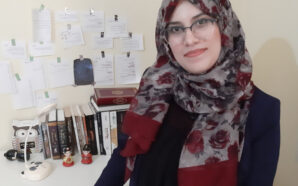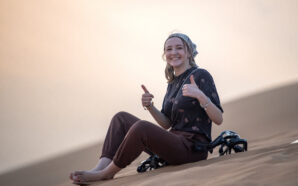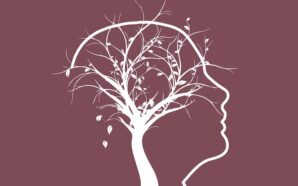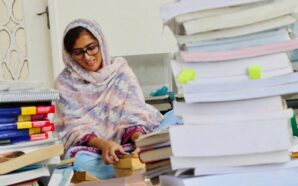Aida Saifi is a humanitarian and development professional with 10 years of experience in international non-governmental organisations, covering humanitarian medical care in hostile contexts such as epidemics, conflicts, emergency response, and natural disasters. She currently serves as the strategic regional partnerships manager of The Fred Hollows Foundation. In her role, she is responsible for building and maintaining strong partnerships with major funders and work with them to have a greater impact in addressing blindness. Before joining The Foundation, Aida worked at Doctors without Borders and Restless Development. She holds a Bachelor's Degree in Sociology and Anthropology, and Master’s Degree in Community Development.
- Tell us about yourself, your choice of education and initial work.
I was born and raised in East Jerusalem, to a family of doctors and nurses. Their work exposed me in my early years to rural Palestine and the shortage of health and medical service. I remember hiding under my father’s clinic bed watching him work. As a Jerusalemite, living in East Jerusalem, it was clear that in order to survive and live in the city, I needed to follow my passion for studying the nature of human beings and their origins. Graduating with degrees in Anthropology, Sociology and Global Community Development Studies has helped me achieve my goal. These experiences have further rooted my resilience and identity as a young Arab woman living in one of the most unrest cities in the world.
My enthusiasm for volunteering in my early years propelled me to actively search for opportunities to help children with disabilities and those coming from disturbed and violent households throughout my academic years. I was determined to use my education to help local charities which in return guided my understanding of the world around me, as well as helping me understand the world’s impact on Palestinian daily life in East Jerusalem and beyond.
- Belonging to a region that is engulfed in conflict, pain and suffering, how important it is to have individuals and especially women (representation) like yourself in the development sector?
There has been a relative recent urge for women to play a larger role in the international nonprofit sector.
Moreover, a general notion to localize their efforts and work. Before realizing that a terminology has emerged from years of foreign aid work in the region, we always lead in our own contexts, usually for reasons of cultural sensitivity. However, it wasn’t always properly acknowledged, especially for women. Furthermore, Arab women are encouraged to find their way, while explaining to us that challenging choices will be filled with obstacles, inherited ones.
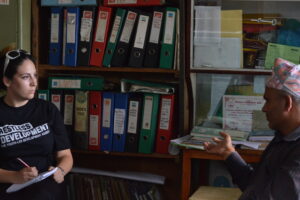 I am proud to be an Arab woman and the achievements which have shaped and molded my life. I am certain that my unique perspective allows me to understand the overwhelming pain and suffering of many has empowered me to facilitate the alleviation to this suffering and its causes.
I am proud to be an Arab woman and the achievements which have shaped and molded my life. I am certain that my unique perspective allows me to understand the overwhelming pain and suffering of many has empowered me to facilitate the alleviation to this suffering and its causes.
In my early days working as an interpreter in refugee camps in the West Bank. Being the only female in the group of researchers I distinctly remember certain interviews and observations which required female Palestinian perspective to facilitate the translations. In such delicate circumstances, it was and is very important to translate and interpret the nuances of both the spoken and unspoken words by reading the context, understating various expressions and interpreting the Palestinian refugee narrative and experience as a whole.
- What are the challenges as a humanitarian and development professional when working within hostile contexts and dealing with medical care?
I recall a vivid experience while working with Doctors Without Borders (MSF) in East Jerusalem and the West Bank. It was New Years Day, and a field visit brought my team and I to one of our mental health program areas in East Jerusalem, to conduct assessments and to meet our patients who were mainly children with their mothers. Without warning, an attack was shot in our direction. People were screaming and running in all directions in a panic. Fortunately, no one was physically harmed but you can imagine the trauma that this caused to the children. I went home that day thinking, how can we empower these kids and build their resilience and improve their mental health when even as adults who are seemingly accustomed to these situations, we are still horrified and shocked by these sudden and unprovoked attacks.
You feel helpless at times when you don’t have answers or the means to help the immediate needs of the group of people you are supposed to support.
Moreover, operating in conflict areas requires a level of trust and safety to be able to perform the honest duty you are assigned to. That is not always easy, as opening up and sometimes asking for support comes with the threat of being exposed to the community and its prejudiced stigma toward mental health needs.
We operate under clear humanitarian charters. It is not easy to share stories of patients as we try to perform our duties with the utmost respect for the patient centered approach. Respecting their privacies, although in sometimes not be the safest one is a constant dialogue among the corridors of many humanitarian agencies, in the end we should not impose our ways of working nor our solutions, it is a combination of knowledge, experience and trusting the local expertise.
- Based on your experience as well as your Masters degree in Community Development, in your opinion, what kind of strategies and planning are needed to identify a community’s development needs (in regions of conflict, man-made emergencies as well as natural disasters) in order to deliver better and better interventions?
While there are many ways to approach community development, it undoubtedly is based on adopting a holistic approach grounded in principles of empowerment, inclusion, social justice and collective action. The purpose of community development is to bring people together to work towards a common goal.
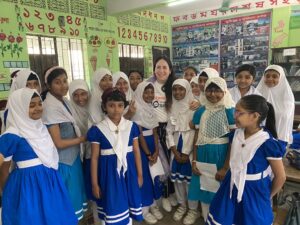 Making it to Nepal after the 2015 earthquakes, hoping to implement all the theoretical work I’d learned at university, made me realize that just as in any context, adapting and re-evaluating the plan is as important as setting the initial plan. At the end of the day, we need to add value and not waste resources to assist the large numbers of people in need in emergency settings.
Making it to Nepal after the 2015 earthquakes, hoping to implement all the theoretical work I’d learned at university, made me realize that just as in any context, adapting and re-evaluating the plan is as important as setting the initial plan. At the end of the day, we need to add value and not waste resources to assist the large numbers of people in need in emergency settings.
Upon arriving in Nepal, I worked on assessing and defining the scope and goals for the community, and with the help of my local mentor and partners, we identified two components of work that could be enhanced and developed with several stakeholders. The first was the actual documentation of the relief work of the local community and grassroots organizations, using evidence to highlight the involvement and contributions of the various community actors and build on it for further projects. The second was to highlight success stories and community champions that came to the challenge in the aftermath of the destruction of the earthquakes. These champions were trained and empowered to tell their stories though their own lenses.
My time in Nepal was eye opening and resulted in looking in an in-depth look into the volunteering trends in times of crisis.
- Can you tell us about your work focusing mental health interventions as well as cultural sensitivity putting it in context of conflict affected regions?
In general, mental health has been stigmatized over the years. One of the key challenges in implementing mental health interventions in times of conflict and post conflict is how to develop trust with people. The ability to open up when many sensitive details cannot be shared outside the immediate family, is part of the journey to recover from trauma or to acquire skills to adapt to difficult recurring situations and hardships.
- How important is it to engage and encourage youth when it comes to emergency response interventions are concerned?
It is indispensable to have youth resources, enthusiasm, innovation, and drive to help. It is also important to identify areas where professional relief and aid workers can delegate work to robust youth to help perform their work. Balanced and well-planned interventions for youth should no longer be overlooked, as I have witnessed in multiple occasions during my time with the Palestinian Red Crescent. With the right leadership and mentorship, young people can work hand in hand with professionals in times of crisis and after math, from simple first aid response and packaging relief kits, to first count observations and actual pioneer projects. Young people have plenty of energy and passion – when deployed and structured, it can create greater impact.
- Tell us about your work at Doctors Without Borders and the role of stakeholder engagement, especially when it comes to mobilizing resources and transfer of knowledge (local capacity building).
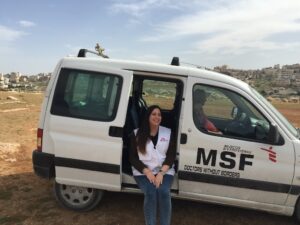 My professional experience with Doctors Without Borders in the UAE, led to a distinct change in my relationship to the humanitarian world. I have been part of a talented regional development and fundraising team. The opportunity to learn about philanthropy and donor engagement in a diverse country like the UAE has been so enriching.
My professional experience with Doctors Without Borders in the UAE, led to a distinct change in my relationship to the humanitarian world. I have been part of a talented regional development and fundraising team. The opportunity to learn about philanthropy and donor engagement in a diverse country like the UAE has been so enriching.
It is satisfying to be able to build philanthropic partnerships with different stakeholders to raise and mobilize funds for emergency responses work in Africa, the Middle East, South Asia, and beyond, from individuals to corporates to running campaigns in solidarity with the world and in action in the times of the COVID pandemic.
The psychology of donors is in essence understating the beauty of helping each other, giving in times of distress, believing in a better future, and recognizing that those who are most in need should get help wherever they are and whoever they are.
The work of Doctors without Borders, through my first-hand experience in Palestine, in Jordan and the UAE, has shaped the way I approach my work and relationship to what I do.
- Tell us about your work at the Fred Hollows Foundation.
I joined The Foundation in 2022 and I was part of Philanthropy and Government Relations team. My role is to lead and build regional strategic partnerships with like-minded organizations to deliver a world in which no person is needlessly blind or vision impaired. Partnerships team don’t work alone, and we work together closely with internal stakeholders such as public affairs and programs as well as external stakeholders such as philanthropists, Official Development Assistance, and corporates. The role provides a great blending opportunity from strategic thinking, relationship-building skills, to a deep understanding of the philanthropic landscape to ensure sustainable impact.
- The Foundation has an impactful footprint across the Global and we have seen that in Palestine as well. Can you tell us more?
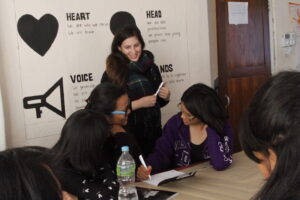 The Fred Hollows Foundation has been working in Palestine since 2013. It was among the first international development organizations aiming to fight avoidable blindness and vision impairment in East Jerusalem, West Bank and Gaza. Currently The Foundation is focusing on treating the leading causes of vision loss by treating patients, training the national health workforce, equipping facilities, and strengthening health systems in collaboration with our local implementing partner.
The Fred Hollows Foundation has been working in Palestine since 2013. It was among the first international development organizations aiming to fight avoidable blindness and vision impairment in East Jerusalem, West Bank and Gaza. Currently The Foundation is focusing on treating the leading causes of vision loss by treating patients, training the national health workforce, equipping facilities, and strengthening health systems in collaboration with our local implementing partner.
- The Foundation also focuses on culture, please explain what that entails?
Culture is one of our strategic drivers to ensure all people have more equitable access to better eye health outcomes and can contribute more to their communities economically, socially and culturally.
Different approaches will be needed in different contexts. For example, women make up around 55 percent of people globally with vision loss. One of the causes on why women and men experience different rates of vision loss are barriers created by social and cultural factors and traditional gender roles.
To close the gender gap in eye health, we must understand and respond to the cultural and local circumstances that give rise to gender inequities. We develop locally-based solutions to achieve gender equity and empower women and girls. So, we understand the context and the needs of patients, treat men as allies and beneficiaries of gender equity within eye health, and build the capacity of our staff and partners in gender equity.
In addition, as strategic regional partnerships manager I bring the voice of our patients, partners, and donors into our conversation and factor in what they might need in my decision making to ensure we have sustainable impact in eye health.
I do operate with the words of Peter Drucker who said: “Culture eats strategy for breakfast”. That is my compass always, in fundraising, partnerships and field work.
- How do development organizations and their representatives work or plan strategies in terms of aid, development, work on the ground in hostile environments?
Many organizations employ various strategies to achieve their objectives, such as advocacy, capacity-building, engaging and empowering communities, fundraising, resource mobilization, and collaboration with other stakeholders to create greater impact. In addition, they support partners and staff on the ground to be able to perform their work and assess and adapt the plans to accommodate the most urgent needs.
- Any last words?
I deeply wish we reach a time where humanitarian aid will only be needed in unfortunate natural disasters or disease outbreaks – and not for man-made crisis. I also hope we reach a level where development work achieves its goals and find communities self-sufficient, well equipped to carry on the work and close the circle.








